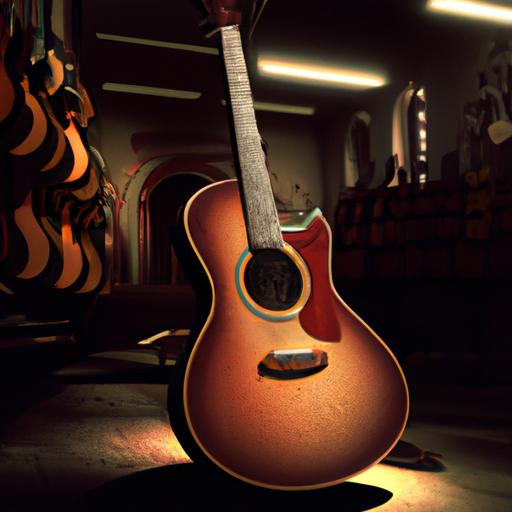For guitar players, the nut is an essential part of the instruments setup, and its important to know how to remove and replace it.
In this article, well provide some useful tips and tricks for safely and effectively removing the nut from your guitar.
Well start by discussing the preparation that needs to be done before removing the nut, then move on to the steps that need to be taken to remove and replace it.
Well also discuss the different types of nuts available and the importance of reusing the nut if possible.
By the end of this article, youll be ready to tackle the job of removing and replacing your guitars nut like a pro!
Table of Contents
Short Answer
To remove the guitar nut, you will need a nut file and a small flathead screwdriver.
Start by loosening the strings and carefully prying up the edges of the nut with the screwdriver.
Once the nut is loose, use the nut file to file down the nut until it is flush with the fretboard.
Finally, use a small hammer to gently tap the nut off the fretboard.
Preparing to Remove the Nut
Removing the nut from a guitar can involve both simple and complex steps, depending on the type of instrument, the type of nut, and the level of experience of the guitar player.
Before beginning the process of removing the nut, it is important to gather all the necessary tools and materials.
Loosen the strings to relieve tension on the nut, and then remove the strings from the tuning pegs.
If the nut is held in place with screws, make sure to have the correct size screwdriver.
If the nut is held in place with glue, you will need a solvent to dissolve the glue.
It is also important to have a flat object, such as a small screwdriver or thin-bladed knife, to gently pry the nut off the fretboard.
Finally, it is a good idea to have a clean rag and some lubricant to clean and lubricate the nut after removal.
Removing the Strings

Removing the strings from your guitar is an important step in the nut removal process.
Start by loosening the strings one at a time, taking care not to disturb the tuning of the strings.
Once the strings are loosened, use wire cutters to remove them from the tuning pegs and the bridge.
Be sure to keep track of which string was in which position to make re-stringing easier.
If you plan on re-using the strings, place them in a safe location until you are ready to restring your guitar.
Unscrewing the Nut
When it comes to unscrewing the nut of your guitar, its important to take your time and be gentle.
Depending on the type of nut, it may be held in place with glue or screws.
For screws, use a properly sized screwdriver to loosen the screws that hold the nut in place.
Be careful not to apply too much pressure, as the screws may be delicate and easily stripped.
For nuts held in place with glue, you will need a tool such as a nut splitter or a thin pick to break the seal of the glue.
Once the glue is broken, you can then use a screwdriver to gently pry the nut off the fretboard.
You may also need to use a screwdriver to loosen the strings if they are not already removed.
When unscrewing the nut, it is important to proceed slowly and gently.
If you apply too much force or attempt to unscrew the nut too quickly, you may end up damaging the screws or the nut itself.
Once the nut is removed, you can then proceed to replace it with a new one or the same one can be reused after cleaning and lubrication.
It is important to follow the manufacturer’s instructions when replacing the nut, as the incorrect installation can lead to problems with the instrument’s playability and sound.
Gently Prying off the Nut

Gently prying off the nut from a guitar can be a tricky process, but it’s necessary in order to properly maintain and repair your instrument.
Depending on the type of nut, it may be held in place with glue or screws.
If the nut is held in place with screws, it can be removed with a Phillips head screwdriver.
However, if the nut is held in place with glue, it must be gently pried off with a flathead screwdriver or other appropriate tool.
Do not use too much force when prying off the nut, as this may cause damage to the nut or the fretboard.
If the nut is difficult to remove, it may be helpful to apply gentle heat to soften the glue and make it easier to remove.
Once the nut is removed, it can be replaced with a new one or the same one can be reused after cleaning and lubrication.
It is important to follow the manufacturer’s instructions when replacing the nut, as the incorrect installation can lead to problems with the instrument’s playability and sound.
Different Types of Nuts
Guitar nuts come in a variety of shapes and sizes, and each type has its own purpose.
Nuts can be made from a variety of materials such as bone, plastic, graphite, brass, and even shell.
The material used will affect the sound of the guitar, as well as the playability.
An important factor to consider when selecting a nut is the size of the nut slots in the neck of the guitar.
If the nut slot is too small for the nut, it can cause intonation issues.
The most common type of nut is the plastic nut, which is usually found on electric guitars.
This type of nut is easy to install and is less expensive than other types of nuts.
It is also a popular choice for beginner guitarists because it is relatively easy to replace.
Bone nuts are a popular choice for acoustic guitars because they provide better sound quality and a smoother feel.
Bone nuts are more expensive than plastic nuts and require more skill to install.
Graphite nuts are a popular choice for electric guitars because they are lightweight and provide a smoother feel.
This type of nut is also more expensive than plastic nuts, but it is easier to install and requires less maintenance.
Brass nuts are a popular choice for electric guitars because they provide a vintage look and sound.
Brass nuts are more expensive than plastic and graphite nuts, but they are easier to install and require less maintenance.
Shell nuts are the most expensive type of nut, but they provide the best sound quality.
These are usually found on high-end guitars and require more skill to install.
No matter what type of nut you choose, it’s important to make sure that it is firmly in place and the correct size for your guitar.
Following the manufacturer’s instructions is the best way to ensure that your guitar nut is installed correctly and provides the best sound quality.
Reusing the Nut

Reusing the nut is a great way to save money, as well as being a great way to preserve the unique character of your instrument.
When reusing the nut, its important to clean and lubricate it first.
This will ensure that the nut functions as intended and doesnt cause any problems with the instruments playability and sound.
Before you begin, its a good idea to take a few pictures of the old nut and its positioning on the fretboard.
This will help you remember exactly how to position the new nut when its time to put it back on.
When youre ready, use a soft cloth to gently wipe away any debris or buildup from the nut.
This can include dust, dirt, and any residue left over from the previous installation.
Once the nut is clean, its time to lubricate it.
This will ensure that the nut slides easily into place when you reinstall it.
You can use a light lubricant, such as WD-40, or a special guitar nut lubricant.
Be sure to wipe away any excess lubricant before reattaching the nut.
Finally, youll need to reattach the nut to the fretboard.
Depending on the type of nut, it may be held in place with glue or screws.
If youre using glue, be sure to use the same type and amount as before, and apply it evenly.
If youre using screws, remember to take the pictures you took of the old nut positioning and use them as a guide.
Once the nut is securely in place, youre ready to reattach the strings and enjoy your instrument!
Installing a New Nut
Once the old nut is removed from the guitar, it is important to properly install a new one.
While different types of nuts vary in installation process, there are a few general steps that should be followed.
First, it is important to make sure that the nut is the correct size for the guitar.
The nut should fit snugly in the slot at the end of the fretboard, and the saddle should be parallel with the strings.
If the nut is too large or too small, it may cause tuning or intonation issues.
Next, the nut should be applied with a small amount of adhesive.
This will help keep it in place and prevent it from shifting during play.
If the nut has screws, these should be tightened until the nut is snug, but not overly tight.
Finally, the strings should be reattached and tuned to the correct pitch.
Once the strings are in tune, the nut should be checked to ensure that it is properly installed and is not causing any tuning or intonation issues.
If the nut is adjusted correctly, it should not cause any problems with the instrument’s playability or sound.
Final Thoughts
Removing the nut from a guitar is an essential part of guitar maintenance and repair.
With the right tools, it’s a relatively easy process that can be done in a few steps.
Different types of nuts are held in place with various methods, and some may require extra care when removing.
Once the nut is removed, it can be replaced or reused after cleaning and lubrication.
With the tips and tricks in this article, you have all the information you need to remove your guitar nut and make sure it’s in top shape for the best sound and playability.
Get out there and start working on your guitar!

